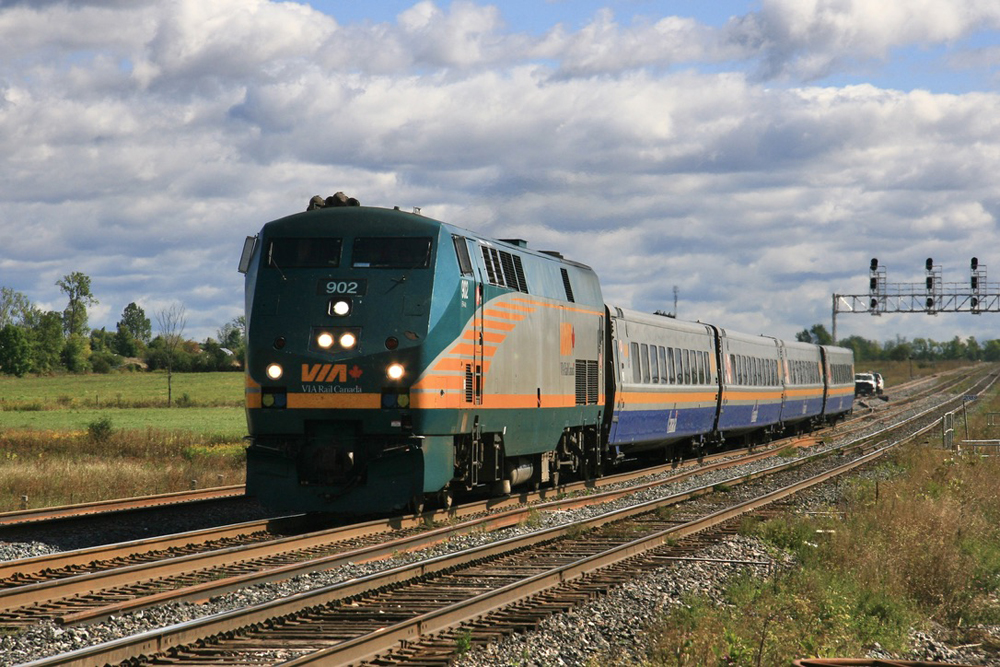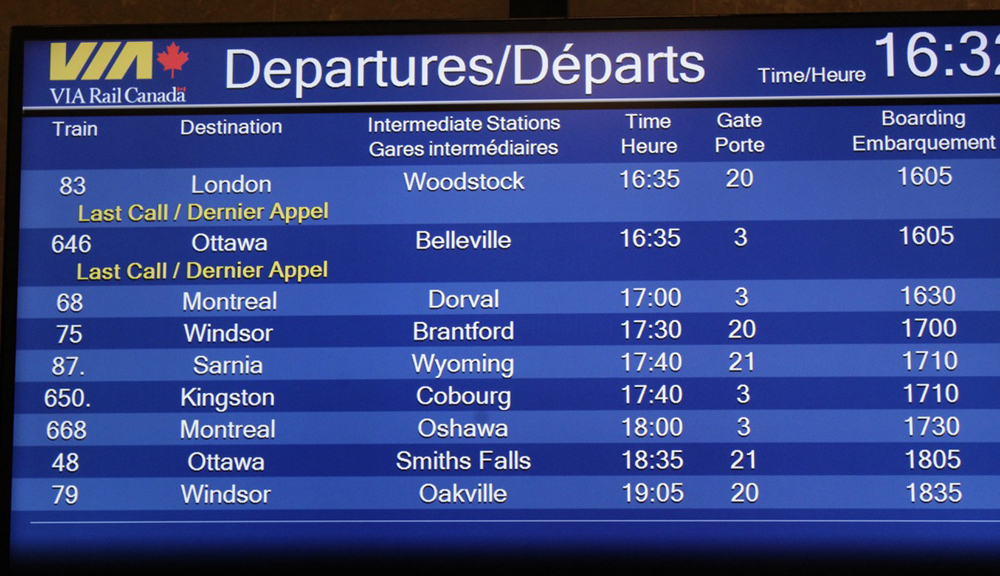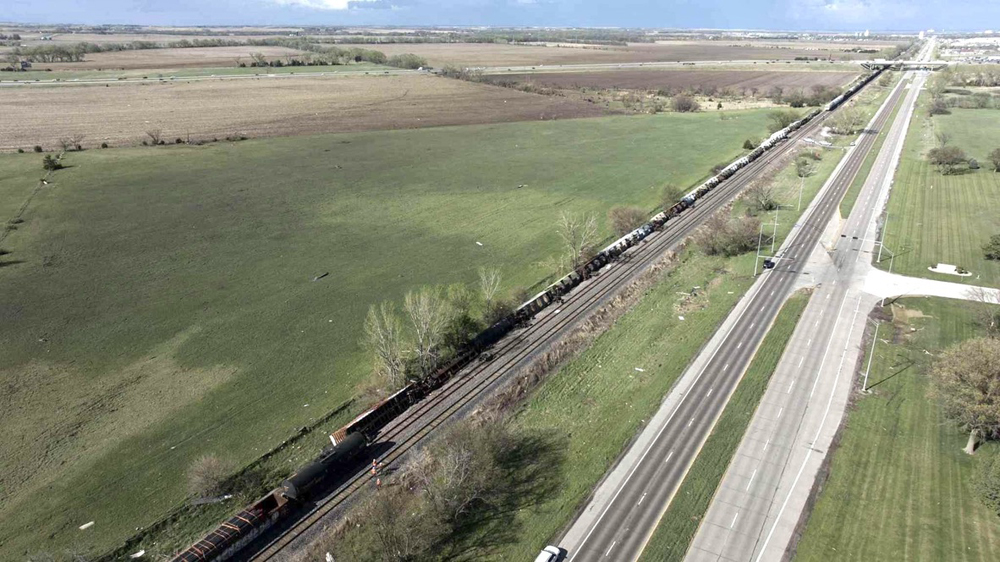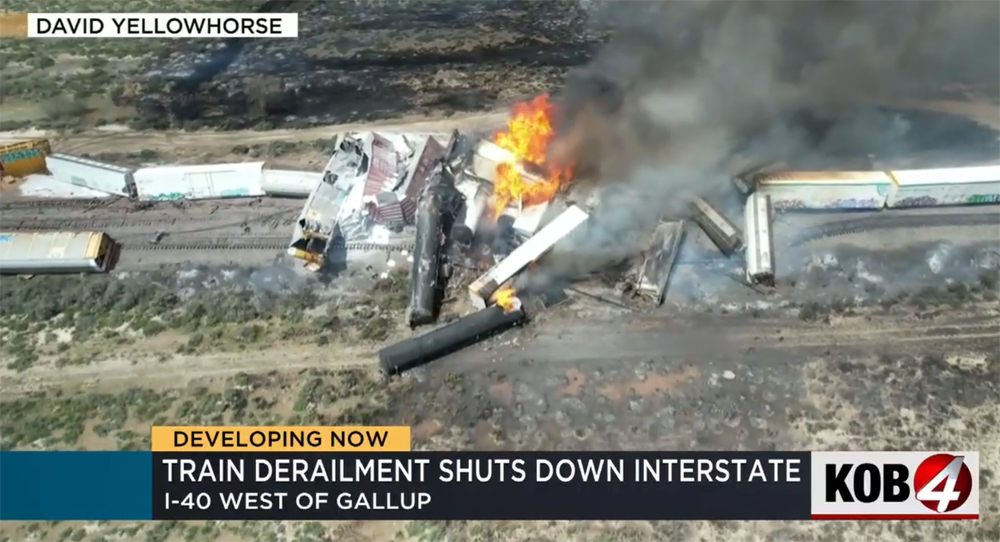
WINDSOR, Ontario — Admitting that the government’s focus so far has been on corridor rail improvements east of Toronto, Canada’s transport minister announced Tuesday his agency will explore options to “improve passenger rail frequencies, on-time performance, and shorten travel times in Southwestern Ontario.”
Minister Omar Alghabra said Transport Canada “will seek an external advisor, who will analyze passenger demand and route options to deliver on rail service that best meets the needs of communities“ in the region, and look at “concrete options to enhance service …for potential future integration into the High Frequency Rail project.” The report from this outside source is due by the end of 2023.
The area is currently served by four VIA Rail Canada Toronto-Windsor round trips and one between Toronto and Sarnia, Ont., over Canadian national trackage. GO Transit last year added a round trip from Toronto to London, Ont., via Stratford, the same route used by VIA’s Sarnia train.

Commissioning a years-long independent study — rather than directly and immediately collaborating with stakeholders like VIA, GO Transit, and CN — is similar to the approach announced by Alghabra when he cut VIA out of evaluating the feasibility of creating a passenger-only Toronto-Ottawa-Montreal-Quebec City right-of-way [see “Transport Canada inches forward …,” Trains News Wire, March 10, 2022].
For that multi-billion-dollar project, the government is seeking third-party “expressions of interest” on constructing and operating the line. Proposals from qualified applicants won’t be due until fall 2024. Alghabra made no mention of studying a separate right-of-way or operator for the Southwest Ontario study.
He did note that government funds were appropriated to upgrade VIA stations at Chatham, Brantford, and Sarnia, as well as the introduction of new Siemens trainsets later this year.
It isn’t clear from Tuesday’s announcement if Transport Canada recognizes or will address recent track-condition and congestion delays while the study is being completed. On Monday, Aug. 29, nine of the 10 VIA trains operating between Toronto and either Windsor or Sarnia experienced delays ranging from 23 minutes to 1 hour, 22 minutes, according to data compiled by transportation analyst Greg Gormick. Tardiness was especially bad on Tuesday, Aug. 9: seven of 10 trains had delays ranging from 51 minutes to 2 hours, 47 minutes. Trip times are scheduled for 4 hours to 4 hours, 40 minutes on the two routes.














I don’t think many routes in North America will be able to justify installation of catenary to power electric locomotives. The more likely scenario in my opinion is hydrogen fuel cells. Hydrogen production using nuclear and renewable generated electricity is not highly efficient. Hydrogen consumed in fuel cells is significantly less efficient than batteries but has a role to play for railroad locomotives and other high power, off-grid equipment.
Yes Roger, OPG has and continues to do a good job, however moving forward I’m concerned about NIMBY’s getting in the way and bureaucrats creating hoops to jump through. You mention the pumped storage facility on Georgian Bay, the NIMBY’s are out in full force on that one already.
With the move to EV,’s (cars, buses, light and medium trucks) the push to eliminate gas residential furnaces and gas ranges, we need to get going now on the entire system, not just generation. This effort will need to include the neighbourhood distribution system, most residential services will need to be updated to 200 amp minimum. The grid will most likely need doubling in capacity if his is indeed the desire moving forward. Again NIMBY’s for the transmission lines.
I’ve touted SMR’s in previous posts here, great idea until they go to drop one in someone’s backyard, NIMBY’s will rejoice at the massive gathering this will bring on. Look at the uproar on both sides of Lake Huron over the spent nuclear fuel depository they want to build in South Bruce.
With Dofasco installing two massive EAFs in Hamilton and Algoma going EAF as well in the Sault maybe they will be able to install onsite SMR’s. Dust scared the locals, hate to think about a reactor. These EAF’s will greatly increase the electrical load at both facilities.
And I know SUNCOR is really interested in in the oil sands, they produce power today for themselves and sell surplus into the grid and it’s very expensive power as well as dirty.
.
Anyway the intent of my initial post around power moving forward is in regards to electrifying the North America rail system. With our systems and electrical grid tied together, some jurisdictions are doing good while others are struggling to provide a reliable power supply and in the case of the two mentioned sources in the SW, may be in jeopardy.
The powers that be in Canada, most of them graduates of the WEF Davos crowd, have no interest in passenger rail, unless there is some cronyism aspect associated. Farming out studies and having different operators is like the UK and EU model. Further, Canada has loads of filthy tar sands oil to burn. And burn it they will. Facilitating automobile use is a two-fer to burn oil and have suburban sprawl. Anyone that has driven on the 401 near Pearson Airport will get it… it is an 18 lane monstrosity that is mostly a parking lot a good part of the day.
I got my Classic Trains recently; it had an article on the CN Super Continental. In the same time frame, there were Rapidos between Montreal and Toronto. How far things have fallen.
Canada, like the US simply isn’t serious about passenger rail. If only we could hire the Chinese to build high speed rail…
Thing is, Gregg, as traffic on the 401 west of Toronto has exploded, VIA to London (or Kitchener Waterloo) and beyond hasn’t even stayed near the same level. In SW Ontario, VIA has been cut by half.
When VIA shrinks to 0.000001% of the market, maybe Canada will wake up. Trudeau fils and his ilk consider themselves the world’s greatest environmentalists, but they can’t run a handful of four-car passenger dinkies.
Amtrak for all its immense problems invested in two generations of Amfleet, in the Horizon cars, in two generations of Superliners, in two generations of Acela, and in those single-level eastern cars whose name escapes me at the moment.
What has VIA done for equipment? It bought a small fleet of unsuitable European cars that the Europeans wanted to unload. VIA rebuilt The Canadian’s rolling stock so it could field a twice-weekly cruise train that has absolutely nothing to do with moving the masses of people. VIA started off with a sizeable fleet of plain-Jane, but serviceable, cars from CN’s once-extensive services. Also the RDCs from both CN and CP. Those fleets have never been replaced.
Don’t forget Greg, that filthy tar sands oil powers just about every CN, CP, and GO train operating out of Toronto as well as pretty well every train fuelled west of Toronto all the way to the west coast. Also accounts for 60% of oil imported into the United States so more than likely it makes it way into locomotives in America.
May be a tad bit dirty but beats out Saudi and Russian oil any day.
P.S. I fully support electrification, coast to coast, doubt any of us will be around long enough to see it though.
As we move towards the electrified world, I have yet to see ant major new reliable power source being developed, only shut down (re Pickering in Ontario) and with a bare minimum of ten years to deliver any sound development it’s not happening.
In the SW, Lake Mead and Oro appear to be in jeopardy, as reliable power sources, what is being done to replace this capacity?
The Pickering station is scheduled to shut in 2024. The original plan was to close two reactors this year but studies of the plant determined operation to 2024 is safe.
The Darlington and Bruce stations, a total of 12 reactors, are being fully refurbished (almost a total rebuild) to allow operation beyond 2060. Some reactors had been left idle for years and are being restored to service as part of the refurbishment program.
The Darlington site will get a Small Modular Reactor (SMR) around 300MWe to be operational before the end of the decade. Additional reactors are already approved for Darlington so the project should be able to go ahead without endless reviews. If the first SMR works well then more units could follow. Alberta, Saskatchewan and New Brunswick are involved in the SMR project. New Brunswick has an operating nuclear power plant and expertise that would help them utilize SMRs.
Ontario usually gets over 90% of its power from nuclear, hydro-electric and wind. There is also solar and biomass (coal plant converted to burn wood). At least 3 reactors in Bruce and Darlington are currently off line for rebuild so more power is coming from the gas/oil plant near Kingston and combined cycle gas turbines. The gas turbines provide power when output from the wind farms is lower than normal. There is a proposal under consideration to build a pumped storage facility on Georgian Bay that would help balance the power grid by absorbing off-peak and excess renewable power to fill the reservoir and generating power when demand is high. Additional pumped storage will reduce the need for the gas turbine plants. Ontario already has a pumped storage facility at Niagara Falls.
Plenty of activity in Canada to provide clean power.
Wasn’t so long ago SW Ontario was one of the best served by passenger trains in North America. No longer.
Three events happened. (1) The discontinuance of the very popular Chicago – Toronto train (through Lansing – Flint – Sarnia – London) because of United States government’s insane over-reaction to 9/11. (The terrorists were Saudis, not Canadians.) (2) Trudeau fils’ grotesque, unbelievably moronic over-reaction to COVID. (3) VIA RAIL’s incompetence at a level making Amtrak look great in comparison.
So we need a study? Begin by admitting the three imbecilic mistakes as above, then go from there. You can’t move forward by conveniently forgetting the decisions causing the present conditions.
When the US had 1 million people dead from COVID, Canada had less than 40,000. The US is population is 9 times bigger than Canada so if the US had been as successful controlling the virus then the US death count would have been around 360,000. Canada followed the advice of public health experts not the whims of politicians.
My question is did Canada count COVID deaths the same way as in the US? Per a friend who is in local hospital administration, if the patient happened to have COVID when they died they were counted as a COVID death even if the actual cause of death wasn’t the COVID. [It was done because of the extra money the hospital received from the US government for a reported COVID death.] Did Canada experience the same or were the reported deaths limited to those directly due to COVID?
The publicly funded Canadian health care system doesn’t have the same motivation to report deaths with COVID as deaths from COVID.
Yes, figures don’t lie, liars figure! Dying with Covid-19, is NOT the same as dying from Covid-19!